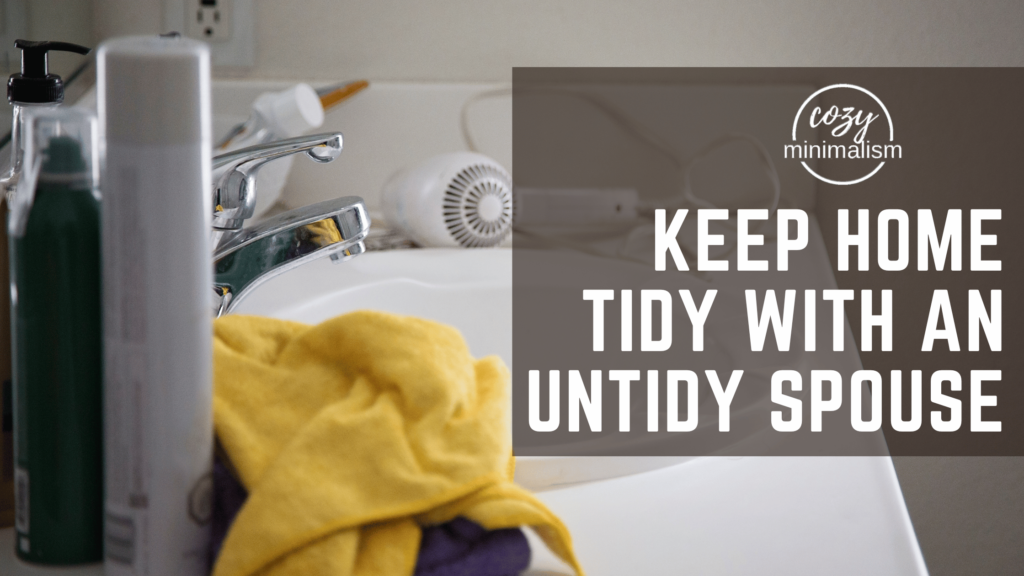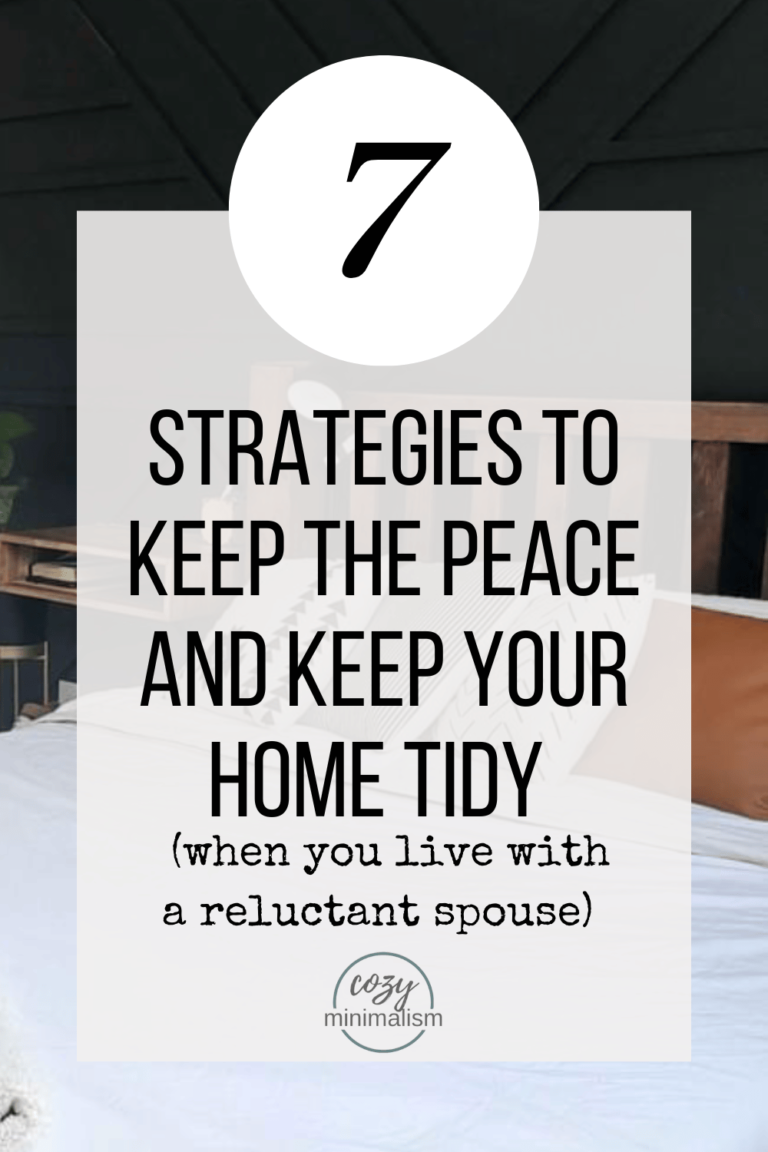
In this post, I’m going to write about how to keep the peace with your untidy spouse and keep your home tidy – because it’s totally possible!
I want to help you explore the concept of compromise as a key strategy for you and your spouse to achieve win/win solutions and provide practical strategies for finding common ground in keeping your shared home tidy.

There are two people in this world. Those who clear the surfaces and those who clutter up the surfaces. And they are usually in a relationship together!
All joking aside, this can be a real problem when you are trying your hardest to maintain a clutter-free home and feel like your spouse is on the opposite end of the spectrum. And sometimes, it can feel like they are undermining you.
Clutter can be a common source of disagreement for couples living together.
One partner may prefer a minimalist approach, while the other may have a sentimental attachment to possessions.
Finding a balance and compromise in clutter management is essential for maintaining a harmonious and tidy home.
It’s important to recognize that individuals may have different perspectives on clutter based on their upbringing, personality, and lifestyle.
What may seem like clutter to one person may hold sentimental value to the other.
Understanding and respecting each partner’s viewpoint on clutter is crucial in decluttering and tidying your shared home.
Take the time to have open and honest conversations about your different perspectives on clutter and acknowledge each other’s feelings and concerns.
Why does one spouse get stressed with things left out and the other not? I joked about this at the beginning of this post, but if you’re experiencing it in your relationship, it can be a real problem.
The key to understanding this is learning about the clutter tolerance gap between you and your spouse.
Your best bet? Figure out what your clutter tolerance level is and what your spouse’s level is.
If you are stressed out by things not being put away and your spouse doesn’t even notice when things are left out, there is a large gap between your clutter tolerance levels, and it will cause tension.
The larger the gap, the greater chance for a rift in your relationship.
Most of the time, just understanding this gap will help you empathize with the other person’s experience.
Each partner may have a different threshold for what they consider clutter. And your goal is to reduce that gap and find a middle ground, and I even have a signature strategy that I use that helps RESET everyone’s clutter tolerance levels in your home.
We compromise and meet in the middle because your home is also their home.
Compromise can lead to solutions that satisfy both partners in this process.
Couples can create a clutter-free home that promotes well-being and happiness by finding common ground.
When we start to compromise, we begin to feel like this process is collaborative. It fosters better communication, mutual understanding, and trust between partners. All of these things are present in a healthy relationship where you want to see your partner happy.
It allows both individuals to feel heard and respected, creating a positive and collaborative environment for decluttering and maintaining a tidy home.
A compromise and a meeting in the middle is ideal, but if you are struggling and the whole weight of your home is on your shoulders, the next step is resetting clutter tolerance levels in your home.
When you can bypass a compromise, I have some guidelines for this:
Minimize to the level of the one that’s responsible for the area being worked on
Minimize to the level of the person most stressed by the current level of stuff

I promised practical strategies at the beginning of this blog post, and I don’t want to turn this into a recipe blog situation, so here we go!
Here are some ideas that will work for both you and your spouse when for keeping your home tidy:
Designate specific areas in your home for personal items or collections that are important to each partner. This allows both individuals to have their own space while keeping the rest of the home clutter-free.
I suggest having rooms in your home where your spouse can put their most prized collections without fear or worry that you will toss them.
I don’t touch Mr.Cozy’s shop or leave his video games alone.
I only want to add that I promise not to declutter his items, and he keeps his sites contained in these spaces.
Alternately, you can also designate areas of the home that contain collective items and give freedom to one spouse to make executive decisions in those spaces with those items.
Identify shared living areas that should be kept clutter-free, such as the living room, dining area, or kitchen. These are all spaces that I refer to as “we” spaces in our home, they are the common areas that we all use, or I use when doing things for the family. Usually, with “we” spaces, I feel the most responsible for keeping them tidy and clean.
Agree on keeping these areas clean and tidy, and hold each other accountable.
I also suggest doing a spatial reset in these spaces to help reset both your and your spouse’s Default Level Of Tidy™… this helps decrease that Clutter Tolerance Gap™ too!
Establish decluttering routines or schedules that work for both partners.
Some Ideas:
A Daily 10-Minute Tidy™ at night before bed of the main living areas
Weekly Decluttering Sessions or Tasks
Implement one day of the week for a specific habit you want to work on together like, “Tidy As You Go Tuesday”
Quarterly Purges of Easy Items
Seasonal Purges
Finding simple routines and schedules that work for both of you can help maintain a clutter-free home.
Seek support from your partner for accountability. I like to get Mr. Cozy to help me stick to my scheduled donation drop-offs because, let’s be honest, sometimes I would leave the bags in the back of my car for months without this.
Sentimental items can be a source of contention when decluttering.
Agree on a compromise where each partner gets to keep the sentimental items that are most important to them and find creative ways to store or display them without cluttering up the space.
Collaborate on finding storage solutions that work for both partners.
This can include organizing systems, storage containers, or furniture that meets both individuals’ needs and preferences.
Don’t get frustrated if you clear off the surfaces in your kitchen and your spouse unloads their pockets on the clear surface.
You have just uncovered a clutter hotspot! A clutter hotspot shows up AFTER you have cleared a surface. It gives you an important clue for what needs to have a solution created.
It’s functional home GOLD!
Work together with your spouse to figure out the best solution, which could be a small basket or bowl on the counter that their pocket can be unloaded into.
Another important aspect of compromise in clutter management is respecting each other’s belongings.
It’s essential to establish a mutual understanding that items belonging to each partner are respected and not tossed out without their consent.
This creates a safe and trusting environment for decluttering, where both partners feel valued and respected.
To successfully work together on clutter management, it’s crucial to approach the process with a supportive and collaborative mindset.
Avoid blaming or criticizing each other’s clutter habits; instead, focus on finding solutions that work for both partners.
A simple ” Could you give me a hand with this? I would like to figure out a place for this stuff to live so we both know where we can put this away.”
Encourage each other’s efforts in decluttering and maintaining a tidy home, and celebrate achievements together. When your spouse tidies up without being asked after supper, make sure you thank them sincerely.
Changing habits and your home won’t happen overnight; communication is a key part of this process. This is a continuous process, and working together will make both of you feel comfortable at home.

By recognizing each other’s perspectives, setting clear boundaries, and collaborating on practical strategies, couples can maintain a tidy home that reflects their individuality and shared goals.
With open communication, respect for each other’s items, and a supportive approach, couples can create an environment that promotes harmony and well-being in their home.
So, remember to work as a team, meet in the middle, and find win/win solutions in your tidy home journey with your partner.
Hoping you have a happy home, and may it be Tidy Ever After™!
Always cheering you on!

And be the first to know when signing up for this course is available for purchase
Click Here
P.S. – Which one will you try with your spouse? Tell me below!
Join our thriving community so your home can be your haven!